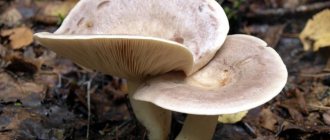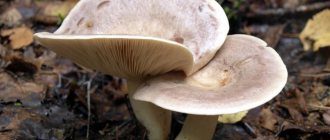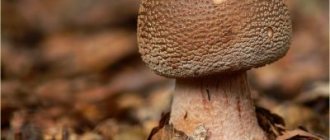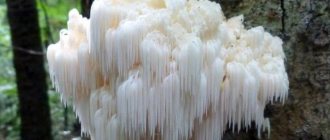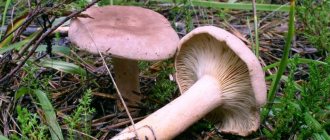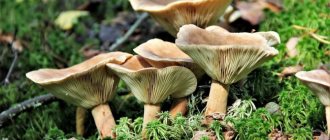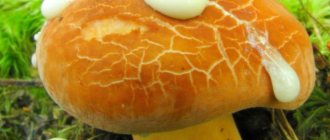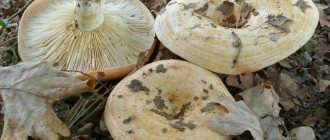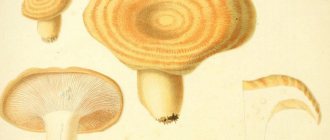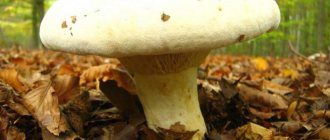Description and photo of the gray-pink milkweed
The gray-pink milkweed is a mushroom that is difficult not to notice in the thicket of the forest, since its appearance just says, “pick me.” What can you do, the mushroom looks really tasty. To collect or not?
From Latin - Lactarius helvus.
hat
The mushroom has a large fleshy cap. It reaches 15 cm in diameter, but is rare. More common are species with a diameter of up to 8 cm. The cap is round, but not spherical, like the vast majority of mushrooms. It is quite flat, and in its central part there is a small tubercle. Over time, when the mushroom matures, the tubercle goes inward and becomes a kind of depression. The edges of the milky rise and tear a little. Thus, the mushroom becomes like a torn umbrella.
When young, the edges are neatly bent down, making the mushroom very fragile and cute.
Particular attention should be paid to the flowers of the milkweed. It can hardly be called homogeneous, since the hat contains shades of white, beige, burgundy, red, pink and red.
At the beginning of growth the color is pale, but over time it becomes red. It is concentrated in the center, but fades significantly towards the edges.
Sometimes you can see peculiar rings on the cap. In the center there are small dark ones, the further they spread out, the whiter they become.
Liquid accumulates on the top of the cap, so the mushroom sometimes becomes glossy. From direct sunlight, the cap often cracks, stains form on it, and it itself is attractive to insects.
Records
The plates are carefully placed under the mushroom cap. They are tightly attached to the stem, not very frequent, and have a pinkish-pale tint, becoming darker over time. The plates are very thin and can be easily deformed with a simple finger press. The spore powder inside is yellow. Sits securely.
Leg
The leg of the milkweed is quite thick and at the same time short, so it can hold such a weighty cap. It reaches a maximum length of 8 cm, but most often does not exceed five. If the milkweed grows in grass, then its leg is short, but if there is moss, it becomes longer. The diameter of the leg is from 1 to 2 cm. At the very beginning of growth, the leg has a gray tint with pink impurities. Quite smooth, darkening at the point of attachment with the mycelium.
However, as it grows, it becomes darker, bumps appear on it, and it can flake.
Inedible milk mushroom pulp
The pulp of the milkweed has a weakly expressed pale pink tint, less often beige or yellowish. Has scanty discharge in the form of milky juice, watery. The smell is very pleasant, but the taste is bitter. Not always pleasant to eat.
Not much, but there is information on Wikipedia.
Composition and beneficial properties
The nutritional value of mushrooms depends on many different conditions. For example, young varieties contain much more nutrients, and fresh ones contain almost 90% water. The proteins of the milkweed contain such valuable amino acids as: tyrosine, glutamine, leucine and arginine. They are easily absorbed by the body and do not spend much money on breakdown. Mushroom fats contain such a useful substance as lecithin. Their number ranges from 0.1 to 0.9%. They also contain fatty acids:
- palmitic acid;
- stearic acid;
- butyric acid;
- acetic acid.
Milkweeds, like other representatives of this genus, contain phosphatides, essential oils and lipoids. In terms of carbohydrate composition, mushrooms are very close to vegetables, but there are others that are characteristic only of this class: glycogen, sugar alcohols, fiber. Their content reaches 16%. They do not contain starch, but they do contain glycogen, which in its composition resembles glycogen of animal origin. In mineral composition, laticifers are rich in potassium, phosphorus and calcium. They also contain trace elements such as iodine, zinc, copper and arsenic. They also contain substances such as mycoinulin and parodextrin, which are responsible for covering the mushrooms with mucus during long-term storage, as well as tregazolyte and lycosote, which provide their taste and nutritional value.
Some of the representatives of this class, due to their beneficial properties and valuable chemical composition, are used in the field of medicine. For example, from camelina and red camelina, the antibiotic lactarioviolin was identified during the process of secreting its milky juice, which has a negative effect on the bacteria that cause tuberculosis. Other types of lacticifers have a positive effect on cholelithiasis, acute and purulent conjunctivitis and other visual lesions. And some even contain antibiotics that inhibit the development of pathogenic bacteria, including Staphylococcus aureus.
Edibility
The question of the edibility of the milkweed is very relevant. Since many mushroom pickers avoid it due to statements about its inedibility. In fact, the history of the milkman is very interesting. It is believed that it is neither eaten nor collected. However, it was never officially presented as inedible.
Moreover, in Europe these mushrooms are eaten in a pre-prepared form. In Finland, the mushroom is generally considered edible and is fried over a fire without any fear. The mushroom has a very specific taste, so it is rarely used in cooking. It is spicy, bitter and goes well with vegetables. This is the main reason why people try to avoid the milky one.
In Russia, this mushroom is considered inedible, but there is no justification for this.
It is worth noting that if prepared incorrectly, lacticaria can actually cause minor poisoning or gastrointestinal problems. However, if he was properly prepared, then such problems will not happen.
Many reference books claim that it is inedible. Although there is a lot of it.
There is a requirement that milkweed should not be consumed by women who are pregnant or lactating, as well as children under 14 years of age.
If you want to avoid serious poisoning, you are advised to prepare this mushroom properly.
- To do this, you need to collect only healthy mushrooms in a basket. But those that have turned yellow, blackened, or are worm-eaten must be discarded.
- When you get home, don’t forget to get rid of any trash you find in the basket.
- After you have gotten rid of the debris, you need to rinse the mushrooms well under running water. This must be done very carefully.
- The milkweed itself is cleaned of the cap skin. This is done in order to protect the mushroom before consumption. It is on the cap that contains a large amount of dust, harmful substances, and insects can also be found there.
- The cap is removed, and the mushrooms are washed again.
- The next step is to boil them. Experts advise separating the stem and cap for this.
- Place the mushrooms in a saucepan and then add cold water.
- Place on fire, bring to a boil and cook for 20 minutes.
- Don't worry if the water suddenly turns yellowish. This will mean that all harmful substances have come out of the mushroom.
Despite the fact that after such preparation the mushroom is considered absolutely safe, it is still not recommended to eat it boiled. Additional heat treatment is required, such as frying, using an oven, and so on. Also, do not forget that such a mushroom can cause a severe allergic reaction. And of course, don’t forget about its specific taste .
Use of blue milkweed in cooking
Blue milkweed is a well-known edible species, but opinions on the quality of its taste vary and are highly individual. For example, American mycologist David Arora considers it "excellent", and the Kansas Mushroom Guide gives it a mediocre rating, as the mushroom has a coarse, grainy texture and a slightly bitter, pungent taste.
Blue milkweed is best prepared by cutting it into thin slices. They turn gray when heat treated. Young mushrooms that produce large amounts of milky juice can be used to add color to marinades. Due to the granular texture of the cap pulp, the blue milkweed cannot be dried.
The mushroom contains about 95.1% water, 4.3 mg fat per gram of mushroom (mg/g), and 13.4 mg/g protein. It also contains healthy fiber and saturated fatty acids.
Blue milkweed is one of 13 species of milkweed sold at farmers' markets in Yunnan province in southwest China. In Mexico, mushroom pickers conduct a “silent hunt” for this mushroom from June to November. In Guatemala - from May to October.
Similar species
Unfortunately, the milkweed can very often be confused with other mushrooms. They can be either edible or inedible. But still, so that such confusion does not become something unexpected for you, we recommend that you get to know your doubles
There are a lot of mushrooms in the lacticiferous family that are similar in appearance to gray-pink ones.
They are similar in shape, cap, and most importantly, in size. Therefore, if you come across something similar to a milkweed, most likely you have a mushroom from this family. Most often this is oak milkweed.
- Also, the oak milkweed has a slightly more grayish shade of the cap, while the gray-pink cap has a pink one.
- The two mushrooms also differ in smell. In gray pink it is bitterish, not very pleasant. And oak has a pronounced taste of wood.
Description
Common milkweed.
The common milkweed has a structure typical for this genus. It is edible, but mushroom pickers often do not pay attention to it.
hat
The common milkweed has a medium-sized cap (up to 15 cm in diameter). Young mushrooms have a rounded cap, the edges are distinctly turned downwards. Its surface is dry and smooth, with an indentation in the middle.
Upon reaching maturity, the cap of this mushroom takes on the shape of a funnel. At an early age, the color of the cap is brownish with a concentric pattern, then changes to a uniform grayish or faint purple. When it rains, the surface of the mushroom becomes slimy and sticky.
Gladysh.
Leg
The leg of the common milkweed can be quite high (up to 15 cm) and not too thick (no more than 3 cm in diameter). The color of the leg is usually the same color, but a shade lighter.
Almost from the very beginning, a cavity is formed inside the leg and with age it expands.
Spore-bearing layer
Agaricus trivialis.
The spore layer is lamellar. The plates are light in color, white-cream. They are located quite often. They may have yellowish spots of frozen milky juice.
Spore powder
The spores are small, compact, round-elliptical. They have pronounced relief. The bulk of the powder is slightly yellow.
Where and at what time does it grow?
Where and when can you find milkweed?
It is believed that this mushroom begins to actively bear fruit at the end of summer. Around August 15, the first mushrooms appear. However, its seasonality is small, only until mid-September. Rarely, when there is no precipitation and the temperature remains high, the milkweed can survive until October. However, it disappears immediately after frost begins. He loves the climate of central Russia; the northern parts and Transcaucasia are also suitable for him.
Found in the CIS countries and Europe. It enters into mycorrhiza with foliage plants. Most often these are birch, larch and spruce. It grows where there is a lot of moss, and the area is generally very swampy.
The milkweed loves moderate temperatures and does not tolerate direct sunlight. They cause cracks to form on his cap.
Also, loves places in swampy areas where there is humidity.
Rules for collection and use
When going in search of zonal milkweed, you should remember that this species grows close to deciduous trees, especially near oak and birch. Mushrooms can be arranged either in groups or individually. To avoid damaging the mycelium, the stem of each specimen should be cut off with a knife. In their raw form they are unsuitable for food. However, you can get very tasty dishes from this ingredient, but only after pre-processing. To do this you should:
- Clear the zonal milkweeds from forest debris, cut off the stems.
- Soak the gifts of the forest in a large container, pressing down with pressure on top.
- Soak for 24 hours, changing the water at least twice.
- Boil the mushrooms without adding salt for about 15 minutes.
After processing, zonal milkweeds can be fried, boiled, or pickled.
Important! After removal from the soil, the shelf life of these mushrooms is one day, so after collection it is necessary to begin processing them as soon as possible.
Benefit and Harm
It is believed that in folk medicine this mushroom is simply necessary. It is a good wound healing agent and stops bleeding. However, there are some disadvantages in using this mushroom, which become harmful to the human body.
- For example, a mushroom contains harmful substances that, if processed incorrectly, can become active and cause gastrointestinal upset.
- In addition, overuse of the mushroom in its unprocessed form can lead to serious poisoning, which will subsequently harm your health.
Time and place of fruiting
This species likes to settle in dense grass at the foot of old oak trees in oak forests, deciduous and mixed forests. Forms mycosis with oak, hornbeam, and beech.
Prefers a temperate continental climate, in Russia it is found mainly in the middle zone. Grows in large groups.
Fruiting time is from July to October.
REFERENCE! In reference books for mushroom pickers, oak milkweed belongs to category 4, that is, a species with mediocre taste and nutritional characteristics. However, the most expensive mushroom in the world, the truffle, is classified in the same category.
What can be confused with
However, the milkman has doubles that are much more poisonous than himself. Among them are the following names.
Oak milk mushroom
This mushroom is conditionally edible. It grows in oak groves, with representatives of which it enters into mycorrhiza. These mushrooms are very similar in shape and parameters. However, the color of the oak milk mushroom cap is no less rich than that of its predecessor.
Gorkushka
Another conditionally edible mushroom. It is not recommended to consume it, but if you decide to experiment, then you need to soak it well first. A distinctive feature is that the diameter is only 12 cm, which is very small for a milkweed.
The cap of the bitter gourd is much thinner; it can easily be deformed by careless hand pressure. The color is more saturated, reddish.
Milky zoneless
This mushroom is small in size, which means the diameter of the cap does not exceed 8 cm. It is flat, the color is more brown than red. Grows in small clusters.
Poisonous milkmen
There are quite a few frankly toxic and dangerous species among representatives of the genus Lactarius, but there are poisonous lacticaria. If you eat them carelessly, you can be seriously poisoned.
Thyroid milky
You can recognize an inedible mushroom by its slightly concave cap with a mucous surface. The color of the mushroom is ocher-yellow, brownish-yellow, acquiring a brownish-violet or purple hue when pressed. The milky juice of the mushroom is white, turns purple in the air, the same thing happens with the white pulp when it is broken. It is not used as food because it is considered slightly toxic.
Orange milky
The mushroom is small in size with a concave-outstretched bright orange cap and has white or slightly yellowish flesh. The mushroom has a characteristic orange aroma, the milky juice is white and does not change color in air. The surface of the mushroom cap is sticky in wet weather and smooth to the touch. The orange milkweed is not suitable for consumption.
Bitter milky
A small-sized mushroom, also called bittersweet, has a pressed dry cap of an ocher-brown, reddish, reddish or copper hue. The flesh of the mushroom is whitish or creamy, the milky juice is transparent whitish and does not change color from contact with air. The mushroom is inedible and is usually not used as food due to its too strong bitterness and acridity.
Brown-yellow milky
A photo of a poisonous milkweed shows a small mushroom with a flattened cap with dry skin of red-brown, dark orange or orange-brown color. The inedible mushroom has whitish flesh with a pungent aftertaste. The milky juice on the break is white, but quickly turns yellow in the air. The fruiting bodies of this species are not used for food.
Wet milky
A mushroom with a depressed mucous cap has a pale gray or almost white color; concentric circles are faintly visible on the surface of the cap. The juice of the mushroom is white and turns purple very quickly when exposed to air; the flesh is also white and acquires a lilac hue when broken. The mushroom does not have a distinct odor, but the taste is bitter and pungent, and therefore belongs to the category of inedible.
Interesting Facts
- The bitter milky sap of the mushroom repels pests, so oak milkweed is almost never eaten by worms.
- In Western Europe, oak milkweed is considered a poisonous mushroom.
Oak milkweed is a typical representative of its genus. For foragers who love broadleaf and mixed forests, this mushroom may seem like an interesting way to expand their mycological knowledge and diversify the traditional mushroom menu.
Information sources
- Kibby J. Atlas of mushrooms: Key to species. - St. Petersburg: Amphora, 2009. - P. 183.
- Jansen P. Everything about mushrooms. - St. Petersburg: Crystal, 2006. - P. 88.
- Harding P. Mushrooms. - M.: AST, 2002. - P. 91.
- Lesso T. Mushrooms. - 2003. - P. 48.
- Serzhanina G.I. Hat mushrooms of Belarus. - Minsk: Science and Technology, 1984.
Evaluation of taste qualities and recipes for preparing oak milkweed
Like other milkweeds, oak is primarily used for salting and pickling. Long-term soaking, as well as the use of vinegar in preparation, allows you to neutralize a special toxic substance contained in these mushrooms - lactarins.
An alternative method to protect yourself from possible illnesses after eating oak milkweed is heat treatment (boiling). These measures not only increase the edibility of the mushroom, but also improve its taste.
ATTENTION! Milkweeds are contraindicated for consumption by people suffering from gastritis and gastric ulcers.
Primary processing
The traditional way to prepare mushrooms for pickling and pickling is to soak them in cold water. The fruiting bodies, previously cleared of dirt and damaged areas, are filled with water and pressed down with a plate with a weight so that the mushrooms do not float. The duration of the procedure is at least 24 hours (ideally 2–3 days). To avoid acidification, it is recommended to change the water every 10–12 hours; if the room temperature is high, then more often.
Cooking
It is an alternative method of primary processing of oak laticifer. Cleaned mushrooms are boiled in boiling salted water for 15–20 minutes. After that, they are thrown into a colander and washed under running water.
Frying
Not everyone will dare to undertake such a culinary experiment, but theoretically you can prepare a roast from pre-soaked or boiled milkweed. To improve the taste, you can add onions, garlic and potatoes.
Pickling
Mushrooms are laid out on the bottom of a non-metallic dish in layers sprinkled with salt. Many housewives add bay leaves and black peppercorns for taste. A pressure is placed on top of the mushrooms, and the workpiece itself is sent to a cool, shaded place. After 7–10 days, you can put the pickles into jars, but they will be ready for use only after a month.
IMPORTANT! The most successful ratio of salt and mushrooms is considered to be 1:25, that is, for 1 kg of oak milkweed you will need 40 g of salt (about 2 tbsp.).
Drying
Like any lamellar mushroom, oak lacticaria is rarely dried for the winter, since with this method of processing very little of the final product comes out.
- For drying, use special electric dryers or ovens.
- Place the cut mushrooms on a wire rack so that they do not touch each other.
- Set the temperature to about 50 degrees, preferably with convection mode.
- Readiness is determined by the properties of the processed mushrooms - they should be fairly dry, but elastic.
False doubles
Mushrooms of the genus Lactaceae are similar in many ways. The main external difference is, as a rule, the color of the cap.
Oak milkweed can be confused with the conditionally edible milkweed (Lactarius serifluus). Both grow in mixed and deciduous forests and have the same structure. However, the color of the watery milky cap is ocher rather than brown. The pulp is brownish-reddish, without the characteristic hay smell.
Watery milkweed (Lactarius serifluus)
The other mushroom's double, the dark milkweed, also known as the alder milkweed (Lactarius obscuratus), is inedible. The name “alder” was stuck thanks to the lactiferous partner tree of the same name, with which the fungus forms mycorrhiza. Alder milkweed differs from oak milkweed in its greater “frailty”
structure (cap up to 3–4 cm in diameter and a very thin stalk - only 5 mm thick, rarer plates) and a barely noticeable tubercle on the cap. The color is ocher-brown with lighter edges. Lactarius obscuratus is an inedible mushroom; when eaten, even after heat treatment and soaking, it can cause gastrointestinal disorders.
The difference between the oak milkweed and its false twins is more clearly shown in the photographs.
Dark milky (Lactarius obscuratus)
